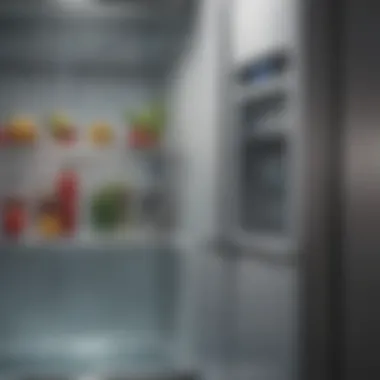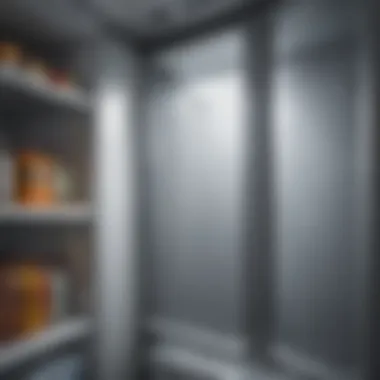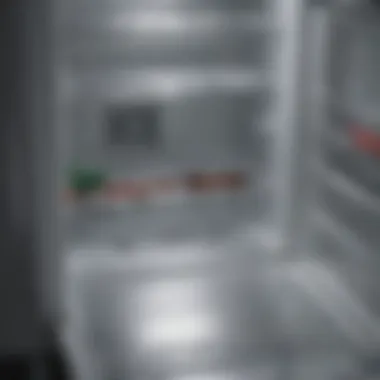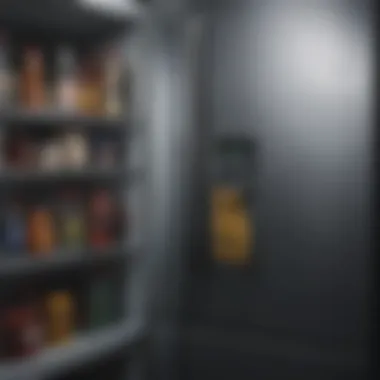Understanding and Resolving Refrigerator Water Leaks


Intro
A refrigerator leaking water from the bottom can be a frustrating issue for any homeowner. This problem not only causes inconvenience but could also lead to more significant issues like water damage or mold. Understanding the underlying causes of a refrigerator leak is essential for effective resolution. In this article, we will explore the common reasons behind this problem, suggested troubleshooting steps, and solutions to mitigate water leakage. Armed with this knowledge, homeowners can promptly address these leaks and ensure their appliances function correctly for years to come.
Common Causes of Refrigerator Leaks
Identifying the cause of a leaking refrigerator is the first step toward a solution. The following are some typical reasons:
- Condensation: High humidity or poor insulation within the fridge can lead to condensation, which may drip out from the bottom.
- Defrost Drain Blockage: Ice buildup in the defrost drain can prevent water from draining correctly, causing it to leak.
- Damaged Door Seals: Worn out or cracked door gaskets can allow warm air inside, leading to excess condensation and dripping.
- Faulty Water Supply Line: If your refrigerator has a water dispenser or ice maker, a damaged or loose water supply line can cause leaks.
"Regular maintenance can greatly reduce the likelihood of leaks in your refrigerator."
Troubleshooting Steps
When faced with a leak, it is essential to troubleshoot effectively. Follow these steps for proper diagnosis:
- Inspect the Drainage System: Check the defrost drain and ensure it is not clogged. If icy, defrost it using warm water.
- Examine the Door Seals: Inspect gaskets for cracks. Replacing the seal can often resolve the issue.
- Check the Water Supply Line: For units with water dispensers or ice makers, inspect connections for leaks. Tighten any loose fittings.
- Monitor Humidity Levels: Use a hygrometer to assess humidity. If consistently high, consider using a dehumidifier in the kitchen.
Solutions for Common Issues
Depending on the diagnosis from troubleshooting, follow these actions:
- Clearing the Drain: If the defrost drain is blocked, use warm water and a turkey baster to clear it or access it with a straightened coat hanger.
- Replacing Door Seals: Purchase replacements that match your model and install them by extracting the old seals and fitting the new ones.
- Repairing the Water Supply Line: For small leaks, apply tape or sealant. For significant damage, replacing the line might be necessary.
- Maintaining Ideal Conditions: Keep your refrigerator door closed most of the time and vacuum coils regularly to improve airflow and reduce humidity.
Closure
Identifying and fixing a refrigerator leak promptly can prevent further complications. Homeowners can save time and money by understanding the common causes and implementing effective solutions. Regular maintenance goes a long way in maintaining the efficiency of your appliance and avoiding emergencies.
Prologue to Refrigerator Water Leakage
Refrigerator water leakage is a common household problem that often goes unnoticed until it leads to more severe complications. Understanding this issue is not just essential for the immediate resolution but also for long-term maintenance of your appliance. An unaddressed leak can damage flooring, cabinetry, or other kitchen fixtures. Moreover, it can lead to mold growth, which poses health risks.
Household appliances are significant investments, and taking proactive measures to troubleshoot and resolve issues enhances their longevity and efficiency. This article provides insights into the mechanics of refrigerators, helping you discern the underlying causes of water leakage and appropriate solutions.
By recognizing the signs of potential leaks and understanding the factors involved, homeowners can act swiftly. This knowledge can minimize repair costs and extend the lifespan of the refrigerator. Ultimately, maintaining a dry environment under your refrigerator prevents not only property damage but also supports better energy performance.
Significance of Addressing Water Leakage
Addressing water leakage in your refrigerator is paramount.
- Prevention of Structural Damage: Continuous leaking can result in costly repairs due to water damage on flooring or surrounding cabinetry. Quick action can save you thousands of dollars in restoration.
- Health Considerations: Water accumulation can create an environment conducive to mold and mildew. This poses health risks to anyone with allergies or respiratory issues.
- Energy Efficiency: A leaking appliance may not operate efficiently. If parts are submerged or constantly wet, this may lead to higher energy consumption.
- Preserving Food Quality: A malfunctioning refrigerator may not maintain optimal temperatures, potentially compromising the safety and quality of stored food.
- Informed Repairs: Understanding potential causes allows homeowners to determine if they can handle repairs themselves or if professional help is needed. Knowing when to seek help is critical for effective problem resolution.
"Addressing a water leak not only protects your investment but also ensures a safer and healthier kitchen environment."
Understanding Refrigerator Mechanics
Understanding the mechanics behind refrigerator operations is crucial for diagnosing and resolving water leakage issues. Familiarity with these systems can help homeowners appreciate how various components interact to maintain functionality. This section will detail the components involved in water management and how coolant circulation impacts condensation, both of which are integral to maintaining a properly functioning refrigerator.
Components Involved in Water Management
Refrigerators consist of several key components that work together to manage water effectively. The most relevant parts are:
- Defrost Drain: This drain channels melting ice away from the freezer, preventing excess water buildup.
- Evaporator Coils: These coils absorb heat from the refrigerator, aiding in cooling and creating condensation in the process.
- Drain Pan: Positioned beneath the refrigerator, this pan collects any water that drains from the defrost cycle.
- Door Seals: Proper seals are essential to minimize warm air entering, which can lead to moisture formation inside the appliance.
Each of these elements plays a pivotal role in water management. If one component fails, it can cause leaks, leading to potential damage and inefficiency.


How Coolant Circulation Affects Condensation
Coolant circulation is a fundamental process in refrigerator mechanics. The coolant, typically a refrigerant, absorbs heat within the refrigerator, cycling through various components. As it passes through the evaporator coils, it cools the interior of the appliance. This cooling generates condensation, turning moisture present in the air into liquid water.
Efficient coolant circulation helps maintain a consistent internal temperature. However, if the circulatory system experiences issues, such as clogs or leaks, it can lead to improper cooling and excessive condensation, ultimately resulting in water pooling at the bottom of the fridge.
Understanding these mechanics not only provides insight into why water leakage happens but also lays the foundation for effective troubleshooting and resolution.
Common Causes of Water Leakage
Understanding the common causes of water leakage in refrigerators is crucial for any homeowner. Identifying these issues early allows for timely intervention and ultimately pays off in reduced repair costs and prolonged appliance life. Knowing the reasons behind these leaks can also prevent potential water damage to your kitchen and other areas in your home. Addressing these common factors not only ensures proper fridge function but also contributes to energy efficiency.
Defective Door Seals
One of the primary reasons for water leakage is defective door seals. When the seals around the refrigerator doors become damaged or worn out, they no longer create a tight barrier. This can lead to warm air entering the fridge, resulting in condensation inside. Moisture that accumulates can drip down and cause water to pool at the bottom. Regularly inspect the seals for cracks or tears, as these may not be visible at first glance. If any damage is found, replacement seals can easily be purchased online or at local appliance stores.
Clogged Defrost Drain
Another common culprit for water leakage is a clogged defrost drain. The defrost drain is a small opening located at the bottom of the fridge, designed to channel melted frost and ice away from the refrigerator’s interior. If the drain becomes blocked with debris or food particles, it can cause water to back up and leak. Periodic cleaning of this drain is essential. A mixture of hot water and vinegar can be used to help clear clogs. Using a small brush can also assist in removing any stubborn blockages.
Ice Build-Up in the Freezer
Ice build-up in the freezer may also lead to leakage issues. When there’s excessive ice, it can block the drainage holes and prevent proper functioning of the dripping system. The melting ice can then overflow and leak from the freezer compartment into the main refrigerator area. It’s crucial to monitor ice levels and defrost the unit periodically. In cases of recurring ice buildup, it may be necessary to examine the freezer for issues with temperature settings or airflow obstruction.
Incorrect Temperature Settings
Incorrect temperature settings could be an overlooked reason for a leaking refrigerator. If the temperature is set too low, excessive condensation can occur inside the fridge. Likewise, if it's too high, food may not remain at the appropriate temperatures, causing spoilage. It is important to maintain the refrigerator temperature between 37°F and 40°F. Regularly check and adjust settings, and consider investing in a thermometer to have an accurate reading of internal temperatures.
Ensure that each of these common causes is thoroughly evaluated to prevent ongoing refrigerator leaks and costly repairs.
Identifying Water Leakage Location
Identifying where the water is leaking from your refrigerator is crucial for resolving the issue effectively. Water leakage can stem from various locations within the appliance. Understanding the source helps in determining the right solution and preventing further damage. Addressing the leak promptly keeps the refrigerator running efficiently and extends its lifespan.
Tracing the Source of Leakage
Begin by observing where the water accumulates. Noticing whether it is pooling under the fridge or inside can guide you to potential problems. Common sources include a blocked defrost drain or damaged door seals. It is helpful to use a flashlight to check for any hidden leaks.
- Check the floor beneath the refrigerator. If it is wet, the issue might be external.
- Open the refrigerator and examine the interior, especially around the vegetable drawers or shelves. Any buildup suggests a leakage problem.
Once you identify moisture, look for specific signs of malfunctioning parts:
- Door seals: Inspect for tears or gaps.
- Defrost drain: Ensure it is not clogged. A blockage will lead to water backing up.
- Ice buildup: In the freezer, check if ice forms and melts into water.
Checking Interior vs. Exterior Leakage
It is essential to differentiate between interior and exterior leakage to apply the correct fixes. If the water is pooling inside your refrigerator, it mostly indicates internal issues. Conditions such as defective defrost drain or clogged ice maker lines could be the culprits.
On the other hand, if the water is seeping out and accumulating on the floor, you might be looking at a more external issue like improperly aligned or damaged door seals.
- Interior Leakage: Potential causes include:
- Exterior Leakage: Possible causes include:
- Blocked defrost drain
- Defrosting issues with the evaporator
- Problems with the ice maker
- Improper door seals
- Increased condensation due to temperature changes in the environment
It is advisable to inspect both the interior and exterior for a comprehensive analysis of the leakage situation.


By pinpointing the exact location of the leak, homeowners can save time and focus on solving the identified problem. This methodical approach ensures not only a more manageable repair process but also minimizes the risk of future leak occurrences.
Step-by-Step Troubleshooting Process
The troubleshooting process for a leaking refrigerator is critical for effectively addressing the problem and avoiding further damage. Understanding the steps involved is essential for homeowners who might encounter this common issue. Not only does a systematic approach enable one to identify the exact cause of the leak, it also allows for timely remedies that can prevent more extensive repairs in the future.
Taking into account various factors can enhance the accuracy of one's assessment. The troubleshooting process is not merely about fixing leaks; it encompasses a thorough examination of how the refrigerator operates and what factors might influence its performance. Here’s a deeper look into the process.
Evaluating External Factors
Before getting into the inner workings of the refrigerator, it’s important to evaluate external factors that might contribute to the leaking. These factors include:
- Environment: Humidity levels can affect condensation. In a highly humid space, a refrigerator may struggle to maintain internal temperatures, leading to excess moisture.
- Level Surfaces: A poorly leveled refrigerator can cause water to pool in the wrong areas. Check if your appliance sits evenly on the floor.
- Ventilation: Inadequate airflow around the refrigerator can cause overheating, potentially leading to condensation issues.
Taking the time to assess these elements can provide valuable insights before delving into more complicated internal investigations.
Conducting Visual Inspections
Visual inspections should be the next step. These checks can often reveal visible signs of complications that could lead to leaks. Here are some areas to focus on during your inspection:
- Door Seals: Examine the rubber seals around the refrigerator doors. If they’re cracked or worn, they may not seal properly, allowing warm air in and causing condensation.
- Drip Pan: Check under the appliance for the drip pan. If it’s full or cracked, it might lead to water pooling at the base of the unit.
- Floor: Look at the flooring around the refrigerator for signs of water damage or large puddles, which might indicate where the leak is coming from.
An initial visual inspection is a key step since it can save time by clarifying where to focus troubleshooting efforts.
Utilizing Sensors and Detectors
If the leak is not readily apparent through visual inspections, using sensors and detectors can help pinpoint the source more accurately. Here are various tools that can be effective:
- Moisture Sensors: These devices can detect water accumulation in areas that aren't visible, providing further insight into the leak's location.
- Thermal Cameras: Infrared technology can help visualize temperature differences, indicating areas of moisture or ice buildup within the appliance’s insulation.
- Smart Home Devices: If equipped, smart fridges often come with built-in sensors that monitor internal conditions. Consult the appliance’s manual to utilize these features optimally.
Sensors and detectors can often illuminate problems that regular inspections might miss, making them valuable in the troubleshooting process.
Addressing Common Issues
Addressing common issues in a refrigerator that is leaking water is critical for effective home maintenance. By recognizing these problems early, homeowners can prevent potential damage to their kitchens, reduce energy consumption, and extend the lifespan of their appliances. Moreover, understanding these issues also helps in maintaining a healthy environment by avoiding mold growth, which can result from excess moisture. This section focuses on specific aspects to consider when tackling water leakage, including the importance of prompt action and thorough investigation.
Repairing Door Seals
The door seals or gaskets of a refrigerator play a crucial role in maintaining optimal internal conditions. If these seals are damaged or worn out, they can allow warm air to enter, causing excessive condensation. This moisture can accumulate and result in leaks. Inspecting the door seals for cracks, gaps, or stiffness is the first step. A simple way to test their integrity is to close the door on a piece of paper; if it opens easily, the seal may need replacing. Repairing door seals can often be done by cleaning them thoroughly or applying a silicone lubricant. If damage is serious, new seals may be necessary, which are generally easy to install at home. Keeping door seals in check is essential for efficiency and preventing leaks.
Clearing the Defrost Drain
The defrost drain is an often overlooked component that can lead to significant leakage when clogged. Ice buildup in the drain can block water, leading to overflow that results in leaks. To clear the defrost drain, start by locating it, often found at the base of the fridge. Using warm water can help melt any ice blockage. Additionally, a mixture of hot water and white vinegar ensures the drain is thoroughly cleaned. Regular maintenance of this drain is necessary to avoid future clogs. By being proactive, homeowners can save themselves from hassle and repair costs.
Defrosting the Freezer
Sometimes, defrosting the freezer is essential in order to maintain the function of the entire refrigerator. If ice builds up excessively, it can block vents and lead to moisture problems that cause leaks. To defrost, simply turn off the freezer and allow the ice to melt naturally or use a hairdryer on a low setting for quicker results. Once defrosted, clear any debris and consider placing towels to absorb water. Regular defrosting can minimize leakage issues and improve overall efficiency.
Adjusting Temperature Settings
Improper temperature settings in a refrigerator can initiate a cycle of condensation that ultimately leads to water leakage. Generally, a fridge should be set at around 37°F (3°C) and the freezer at 0°F (-18°C). If the temperatures are too cold, this can exacerbate ice buildup. Conversely, if it's too warm, it can create excess moisture. Adjusting temperature settings accordingly can resolve many humidity-related issues. Periodically checking and calibrating these settings fosters an environment balanced between preserving food and minimizing leaks. Managing these temperatures reflects the overall efficiency of your appliance and saves energy.
Preventative Maintenance Tips
Taking proactive steps in maintaining a refrigerator is crucial for preventing water leakage from the bottom. Regular maintenance not only prolongs the appliance's lifespan but also enhances its efficiency and reliability. Preventative measures can help homeowners identify potential issues before they escalate into significant problems that require expensive repairs. Regular attention to specific elements can reduce the chances of facing water leakage and other complications.


Regular Cleaning and Inspections
Cleaning the refrigerator is an essential part of maintenance. Regularly cleaning the interior and exterior of the appliance helps remove dust, spills, and debris that can contribute to malfunctioning parts. Additionally, inspecting key areas, including the defrost drain and door seals, allows homeowners to notice any irregularities early.
Many individuals overlook the importance of checking the defrost drain. It can become clogged over time, which leads to water pooling and eventually leaking out. Keeping this area clear can prevent serious issues. Inspections should generally happen once a month to ensure everything is functioning well.
Monitoring Internal Temperatures
Keeping an eye on the internal temperatures of the refrigerator is critical. An operating fridge should maintain specific temperature ranges to prevent items from spoiling and to reduce condensation. Most refrigerators operate best between 35°F to 38°F (1.6°C to 3.3°C). When internal temperatures fluctuate, it can lead to excess moisture.
Homeowners can make use of a thermometer to monitor these levels accurately. If temperatures are consistently too low or too high, adjusting the thermostat or seeking repairs is advisable. This measure can help avoid water pooling and related leaks.
Routine Seal Checks
The door seals on a refrigerator are vital for energy efficiency and preventing moisture buildup. Conducting routine checks on these seals ensures they maintain an airtight fit. Over time, seals can become worn, cracked, or dirty. A simple test is the paper test – close a piece of paper in the door. If it pulls out easily, the seal may need replacement or cleaning.
Replacing worn seals can reduce energy consumption and help maintain internal temperatures effectively, contributing significantly to preventing water leakage.
Regular maintenance is essential for ensuring that your refrigerator operates efficiently and to prevent potential leaks. Establishing a routine can save homeowners time and money in the long run.
By engaging in these preventative maintenance tips, individuals can significantly reduce the risk of their refrigerator leaking water. Understanding the importance of regular cleaning, temperature monitoring, and seal checks contributes to the appliance's overall health. These practices can lead to a more efficient appliance and ultimately a better experience for homeowners.
When to Seek Professional Help
In the journey of addressing leak issues with refrigerators, it is vital to recognize when to call in a professional. Many homeowners instinctively want to resolve problems on their own. While DIY efforts can work in some straightforward cases, certain situations demand expert intervention. Understanding when to seek professional help can prevent further damage and save both time and money.
Signs of Serious Malfunction
Several indicators suggest a refrigerator may be malfunctioning beyond simple fixes. If a homeowner notices persistent leaks despite attempted repairs, this could be a sign of a deeper issue.
Here are key signs:
- Unusual Noises: Loud humming or banging sounds may indicate a mechanical failure requiring attention.
- Constant Frost Accumulation: Excessive frost buildup, especially in the freezer, could mean that the defrost system is not working properly.
- Inconsistent Cooling: If the refrigerator's temperature fluctuates unexpectedly, it can lead to food spoilage and other complications.
- Water Pooling Underneath: Continued pooling of water, even after cleaning the defrost drain, suggests a more complex problem.
Recognizing these signs early allows for timely expert evaluation. Ignoring them can lead to further damage and higher repair costs.
Identifying Repair Needs Beyond DIY
Homeowners often overlook certain complexities involved in refrigerator repairs. When issues extend beyond simple blockages or seal replacements, professional assessments become necessary. Here are considerations for determining when repairs exceed DIY capabilities:
- Electrical Issues: If the refrigerator fails to operate despite checking plugs and circuits, the problem may reside within electrical components, which need a specialized technician.
- Compressor Problems: The compressor is essential for cooling. Any signs of malfunction can require technical expertise that goes beyond basic knowledge.
- Severe Water Damage: If undetected leaks have caused significant water damage, it is, recommended to engage a professional to avoid mold and structural issues.
"Creativity is thinking up new things. Innovation is doing new things."
— Theodore Levitt
Homeowners should carefully consider these aspects. Seeking help doesn’t mean one has failed; it signifies a proactive approach to maintaining appliance integrity and ensuring safety.
The End
In this section, it is essential to highlight the significance of understanding water leakage from a refrigerator. Water leakage can lead to serious implications, not just in the appliance’s efficiency, but also in terms of potential damage to property. Identifying the underlying causes of water leakage is crucial to ensure the durability and functionality of the refrigerator. This article has delved into various aspects surrounding this issue, providing readers with the necessary tools to tackle leaks effectively.
Recap of Key Points
Throughout this article, several key factors related to refrigerator water leakage have been discussed. These include:
- Understanding refrigerator mechanics: This involves recognizing how coolant circulation and various components work together to manage water appropriately.
- Common causes of leakage: Defective door seals, clogged defrost drains, ice build-up in the freezer, and incorrect temperature settings are principal culprits that should be monitored.
- Identifying the location of the leak: Tracing leakage to either interior or exterior sources is vital. A structured troubleshooting process allows one to pinpoint issues accurately.
- Addressing the issues: Solutions like repairing door seals or clearing a defrost drain can mitigate leakage issues directly.
- Preventative maintenance tips: Engaging in regular cleaning and monitoring temperatures can prolong the lifespan of the appliance.
- When to seek professional help: Knowing the signs that warrant professional assessment or repair is equally vital.
By grasping these elements, homeowners can take informed actions to maintain their refrigerators and prevent future leaks.
Final Thoughts on Appliance Care
Proper appliance care is something that every homeowner should prioritize. A refrigerator is often one of the most significant investments in any kitchen, contributing tremendously to food safety and household convenience. Ensuring that it functions correctly not only safeguards the food you store but also helps prevent costly repairs down the line.
Investing time into understanding the mechanics of the appliance and maintaining it well can yield significant long-term benefits. Simple steps such as regular cleaning, checking door seals, and monitoring internal temperatures can help ensure that water leaks become less of a concern.



